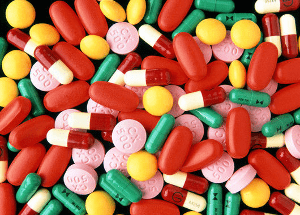Antibiotics are a group of natural or semi-synthetic organic compounds capable of destroying microbes or inhibit their proliferation. At the moment, we know many different types of antibiotics, endowed with different properties.
At the moment there are a huge number of various antibiotics. However, in medicine only a few of them are used; the others cannot be used for the treatment of infectious diseases due to the increased toxicity. Extraordinary diversity of antibiotics caused their classification and their division into groups.

At the same time within the group the antibiotics with a similar chemical structure (derived from the same molecule of raw materials) and action are being assembled.
The group of beta-lactam antibiotics include two large subgroups of well-known antibiotics: penicillins and cephalosporins with a similar chemical structure.
Penicillins are obtained from colonies of mold Penicillium which causes the name of this group of antibiotics – Penicillium. The main effect of penicillin is associated with their ability to inhibit the formation of bacterial cell wall and thereby inhibit their growth and reproduction.
Cephalosporins also belong to the beta-lactam antibiotics and have a structure similar to the structure of penicillin.
Macrolides are a group of antibiotics with a complex cyclic structure. The most famous representatives of the macrolide antibiotic are Erythromycin, Azithromycin, Roxithromycin.
Aminoglycosides are a group of antibiotics that includes drugs such as gentamicin, monomitsin, streptomycin, and neomycin.
The simplest of antibiotics is, of course, penicillin. It was discovered in 1929 by British scientist Alexander Fleming. This was a breakthrough in medicine, because it would soon make antibiotic treatment of patients previously condemned to death, possible. An antibiotic – penicillin kills such bacteria as streptococcus, staphylococcus and pneumococcus.
Since the discovery of antibiotics, more than a year had passed before doctors were able to calculate the correct dose and to produce a relatively safe treatment with antibiotics.
Since then, the science, without any interruptions, produces more and more antibiotics. This happens not only due to the fact that germs are all different in structure and their neutralization requires different tools.
Traditionally, antibiotics are divided into natural (proper antibiotics such as penicillin), semi-synthetic (modified natural product molecules, such as amoxicillin or cefazolin) and synthetic (e.g., sulfonamides, nitrofurans etc). Currently, this division has lost relevance, since a number of natural antibiotics produced by synthesis (chloramphenicol), and some drugs are called antibiotics (fluoroquinolones), de facto are synthetic compounds.
First, the uniqueness of the antibiotics is that, unlike most other drugs, their target receptor is not in human tissues and cells of the organism. Second, the activity of antibiotics is not constant, but it decreases with time, due to the formation of multidrug resistance (resistance).
Antibiotic resistance is an inevitable biological phenomenon, and it is practically impossible to prevent. Third, antimicrobial resistance organisms are dangerous not only for the patient to whom they were allocated, but also for many other people, even separated by time and space. Therefore, the fight against antibiotic resistance is now acquired global dimensions.
Antibiotics are the substances of natural or semi-synthetic origin that inhibit the growth of living cells of the prokaryotic, or, more often, the simplest organisms.
Classification by chemical structure, which is widely used in medical environments, is as following:
Beta-lactam antibiotics, divided into two subgroups:
- Penicillins – produced by colonies of mold Penicillium
- Cephalosporins – have a similar structure with penicillins. The are used in relation to the bacteria, resistant to penicillin.
- Macrolides – antibiotics with a complex cyclic structure. Action – bacteriostatic.
- Tetracyclines – used to treat infections of the respiratory and urinary tract, severe infections such as anthrax, tularemia, brucellosis.
- Aminoglycosides – are highly toxic. Used to treat serious infections, such as septicemia or peritonitis.
- Chloramphenicol – Their usage is limited due to the increased risk of serious complications – bone marrow which produces blood cells. Chloramphenicol has bactericidal effect.
- Glycopeptide antibiotics disrupt the synthesis of bacterial cell wall. They have a bactericidal effect, as well as some bacteriostatic effect against enterococci, streptococci and staphylococci.
- Lincosamides have a bacteriostatic action which is caused by inhibition of protein synthesis by ribosomes. In high concentrations to sensitive organisms it may shhow a bactericidal effect.
- Antifungal – destroys cell walls of fungi and cause their death. The action is analytic. Gradually replaced by high-performance synthetic antifungal drugs.
Popular antibiotics:

Advent Dt
Amoxil
Augmentin
Avelox
Bactrim
Besivance
Biaxin
Ceclor Cd
Ceftin
Chloromycetin
Ciloxan
Cipro
Ciprodex
Cleocin
Dexone
Duricef
Fasigyn
Flagyl
Floxin
Furadantin
Fusiderm B
Ilosone
Keflex
Levaquin
Lincocin
Minocin
Monurol
Noroxin
Ocuflox
Omnicef
Ornidazole
Principen
Rulide
Seromycin
Solosec
Sumycin
Suprax
Tobradex
Tobrex
Trecator-sc
Vantin
Vibramycin
Xifaxan
Zithromax
Zyvox



 (45 votes, average: 3.31 out of 5)
(45 votes, average: 3.31 out of 5)